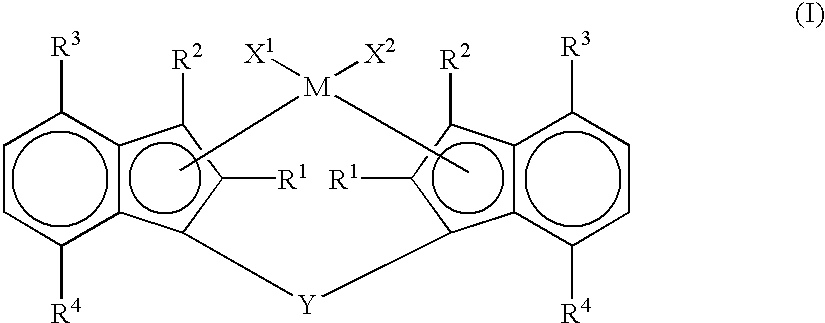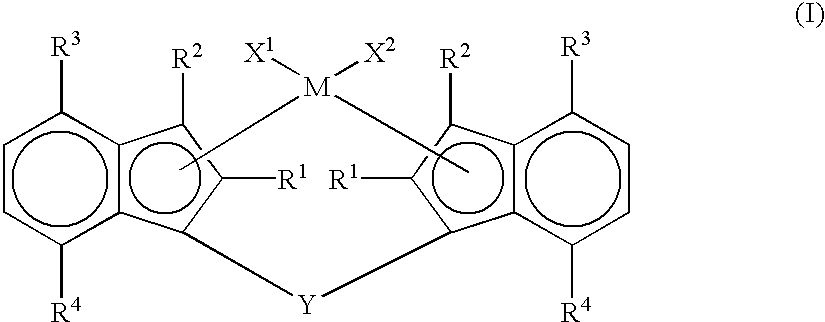Polypropylene composite film
a polypropylene and composite film technology, applied in the field of polypropylene composite film, can solve the problems of poor blocking resistance and scratch resistance of ethylene-vinyl acetate copolymers, poor transparency of high- or low-density polyethylenes, poor heat sealing properties of conventional heat sealing materials, etc., to achieve excellent heat sealing properties, high heat sealing strength, and stable heat sealing operation.
- Summary
- Abstract
- Description
- Claims
- Application Information
AI Technical Summary
Benefits of technology
Problems solved by technology
Method used
Image
Examples
preparation example 1
[0436] Preparation of Propylene / 1-Butene Random Copolymer
[0437] To a 2-liter autoclave thoroughly purged with nitrogen were introduced 900 ml of hexane and 60 g of 1-butene, followed by adding 1 mmol of triisobutylaluminum. After the temperature of the system was elevated to 70.degree. C., propylene was fed so that the total pressure became 7 kg / cm.sup.2-G, and 0.30 mmol of methylaluminoxane and 0.001 mmol (in terms of Zr atom) of rac-dimethylsilylene-bis{1-(2-methyl-4-phenylind-enyl)}zirconium dichloride were further added. The polymerization was performed for 30 minutes while propylene was continuously fed to keep the total pressure at 7 kg / cm.sup.2-G. After the polymerization, the autoclave was released, and a polymer was recovered in a large amount of methanol and dried in vacuum dried at 110.degree. C. for 12 hours.
[0438] Thus, the amount of the polymer (propylene / 1-butene random copolymer) obtained was 39.7 g, and the polymerization activity was 79 kg-polymer / mmol-Zr.multidot....
preparation examples 2-4
[0439] Propylene / 1-butene random copolymers were obtained in the same manner as in Preparation Example 1 except that the amounts of hexane, 1-butene and propylene were used as shown in Tables 1 and 2.
[0440] The properties of the polymers are set forth in Tables 1 and 2.
preparation example 5
[0441] To a 2-liter autoclave thoroughly purged with nitrogen were introduced 830 ml of hexane and 100 g of 1-butene, followed by adding 1 mmol of triisobutylaluminum. After the temperature of the system was elevated to 70.degree. C., propylene was fed so that the total pressure became 7 kg / cm.sup.2-G, and 1 mmol of triethylaluminum and 0.005 mmol (in terms of Ti atom) of a titanium catalyst supported on magnesium chloride were further added. The polymerization was performed for 30 minutes while propylene was continuously fed to keep the total pressure at 7 kg / cm.sup.2-G. After the polymerization, the autoclave was released and a polymer was recovered in a large amount of methanol and dried in vacuum at 110.degree. C. for 12 hours.
[0442] Thus, the amount of the polymer obtained was 33.7 g, and the polymerization activity was 14 kg-polymer / mmol-Zr.multidot.hr. This polymer contained constituent units derived from 1-butene in amounts of 23% by mol, and had an intrinsic viscosity (.eta...
PUM
| Property | Measurement | Unit |
|---|---|---|
| melting point Tm | aaaaa | aaaaa |
| temperature | aaaaa | aaaaa |
| isotactic index | aaaaa | aaaaa |
Abstract
Description
Claims
Application Information
 Login to View More
Login to View More - R&D
- Intellectual Property
- Life Sciences
- Materials
- Tech Scout
- Unparalleled Data Quality
- Higher Quality Content
- 60% Fewer Hallucinations
Browse by: Latest US Patents, China's latest patents, Technical Efficacy Thesaurus, Application Domain, Technology Topic, Popular Technical Reports.
© 2025 PatSnap. All rights reserved.Legal|Privacy policy|Modern Slavery Act Transparency Statement|Sitemap|About US| Contact US: help@patsnap.com



